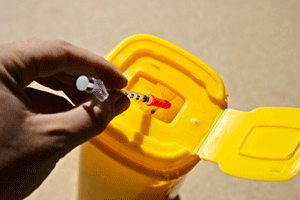Any abuse of Dilaudid (hydromorphone) can have serious health consequences, but the risks of injecting the drug can be even more profound.
Risks include a high possibility of overdose, infection, collapsed veins, cellulitis, and the contraction of blood-borne diseases like HIV and hepatitis C.
Injecting Dilaudid
Dilaudid is a prescription opioid prescribed to people in severe pain. It is approximately six to eight times stronger than morphine and comes in oral and injectable forms.
People may inject Dilaudid so that they can experience the effects faster. Compared to using the drug orally, the results of injecting the drug are nearly immediate.
It is unknown how many people choose to inject Dilaudid, as statistics do not exist for this form of administration. However, it is known that injecting this drug increases the risk of overdose.
Overdose on Dilaudid puts people at risk for respiratory depression, which can be life-threatening. The following are other signs of opioid overdose:
- Confusion
- Bluish fingernails and lips
- Pupil constriction
- Dizziness
- Cold skin
- Weak blood pressure
This drug has a black box warning in the U.S. that states that abuse, misuse, and addiction are possible when someone is using this drug. The chances of all these problems are heightened when injecting Dilaudid.
Heightened Side Effects
When injecting Dilaudid, the risk of side effects is higher. It is more difficult to control the dose taken, and higher doses mean more severe side effects.
When people inject this drug, they usually do so into a vein. This allows the drug to get to the brain almost immediately.
To inject the drug, the user crushes the tablet into a powder. They then mix it with water until it becomes a liquid. This allows them to inject this drug with ease.
When injecting the drug, common side effects of Dilaudid may be more intense.
- Dizziness and tiredness
- Headache
- Nausea and vomiting
- Drowsiness
- Constipation
- Stomach pain
There is also a higher risk of more serious side effects of this drug.
- Slowed breathing
- Feeling lightheaded
- Weak pulse
- Shallow breathing
- Slowed heart rate
- Confusion
- Feeling extremely sad or happy
- Severe drowsiness or weakness
It is also possible for this drug to lower cortisol levels. If this occurs, someone can experience the following:
- Nausea or vomiting
- Dizziness
- Weakness
- Loss of appetite
- Worsening weakness or tiredness
Problems Related to Injection Drug Use
Injecting drugs causes its own set of issues that can affect various parts of the body.
It is not uncommon for a person’s veins to become inflamed or collapsed. This can cause discomfort and bruising at the site of the inflammation or collapse. It can also render the affected veins unusable for injection purposes.
After repeatedly using the veins to inject this drug, it is possible for peripheral blood flow to become poor. This can cause the lower extremities to swell. Fluid accumulates in these areas since blood is not moving at its normal pace.

Necrotizing fasciitis often referred to as flesh-eating disease, is possible in intravenous drug users. It is not common, but when it does occur, it can quickly cause tissue and skin death in the affected area. This infection is known to spread rapidly to other parts of the body. It typically begins at a frequently used injection site.
An abscess can develop at the injection site. An abscess looks like a swollen area, and it includes a pocket of pus. Antibiotics are needed to treat this condition.
Cellulitis is another infection that is not uncommon among people who inject drugs. This skin infection can be painful. The affected area also tends to feel warm, and there is usually noticeable redness in the area.
One of the most serious complications of intravenous drug use is endocarditis. This is an infection that develops in the part of the heart called the endocardium. This infection can be fatal if it is not treated. An infection elsewhere can travel to the heart, resulting in endocarditis.
Injection drug users are at high risk for contracting blood-borne diseases from sharing needles. HIV and hepatitis C are commonly spread this way.
Dilaudid on the Street
If someone is getting Dilaudid from the street, there is no guarantee that it actually contains hydromorphone. People might mix this medication with other drugs in an attempt to save money during the manufacturing process, so fake Dilaudid may be cut with any number of other drugs.
Many street opioids are mixed with fentanyl, a synthetic opioid. Compared to morphine, this synthetic opioid is 50 to 100 times stronger. It is made illegally and imported from other countries throughout the world to mix with other opioids.
When synthetic opioids like fentanyl are part of a mixture, the chances of overdose are much higher. In the U.S., overdose deaths are most commonly associated with synthetic opioids.
When someone mixes fentanyl into another drug, such as Dilaudid, there is no guarantee regarding the dosage of each drug in the mixture. This can cause an overdose even when someone believes they are taking their normal dose. Overdoses from fentanyl-laced drugs are on the rise.
The Bottom Line
There is no safe way to inject Dilaudid. When used properly, the injectable form of this drug is only used in hospitals under direct doctor supervision due to the potential for problems.
When using this drug illicitly and injecting it, the risks are high. Fatal overdose is very likely.
